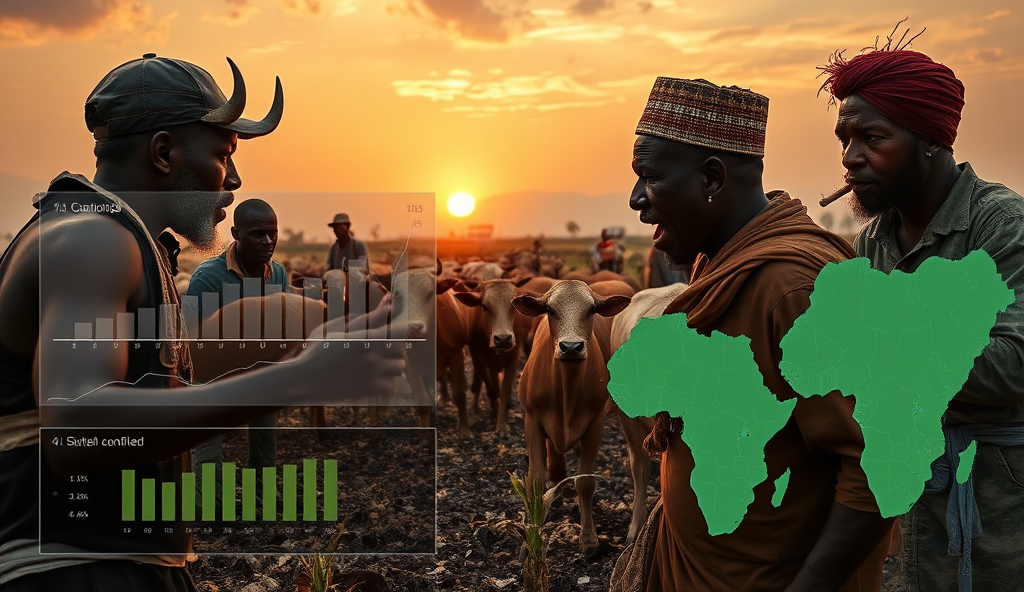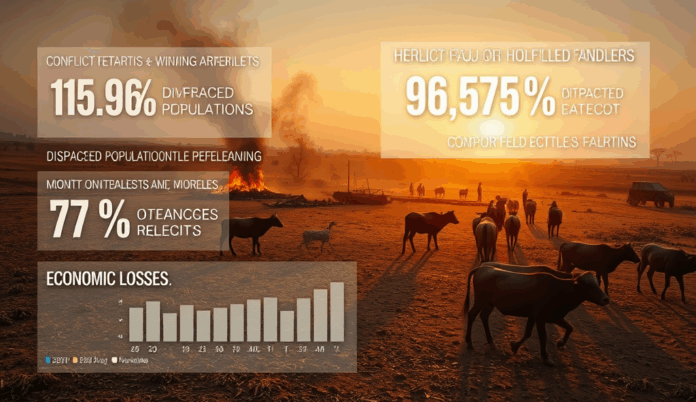Introduction to the Herders-Farmers Crisis in Nigeria
The herders-farmers crisis in Nigeria represents one of the country’s most persistent security challenges, rooted in competition over land and resources between nomadic pastoralists and agrarian communities. According to the International Crisis Group, clashes have claimed over 8,000 lives since 2011, disproportionately affecting states like Benue, Plateau, and Taraba.
These conflicts often escalate due to climate-induced desertification, forcing herders southward into farming regions, where disputes over grazing rights trigger violence. The Nigerian government’s proposed grazing reserves have further polarized communities, with farmers viewing them as land grabs while herders demand access to traditional routes.
Understanding this crisis requires examining its historical roots, which shaped the current tensions between Nigeria’s diverse ethnic and economic groups. The next section will explore how colonial policies and post-independence dynamics intensified these conflicts over time.
Key Statistics

Historical Background of the Herders-Farmers Conflict
The herders-farmers crisis in Nigeria represents one of the country’s most persistent security challenges rooted in competition over land and resources between nomadic pastoralists and agrarian communities.
The roots of Nigeria’s herder-farmer tensions trace back to pre-colonial times, when pastoralists and agrarian communities coexisted through seasonal grazing agreements. British colonial policies disrupted these arrangements by introducing land tenure systems that favored sedentary farming, marginalizing nomadic herders and sowing seeds of discord.
Post-independence governments further exacerbated tensions by neglecting pastoralist needs while prioritizing agricultural expansion, particularly in Nigeria’s Middle Belt. The 1978 Land Use Act centralized land ownership under state control, eroding traditional grazing routes and fueling disputes over resource access.
Climate pressures since the 1980s intensified these historical grievances, as desertification pushed herders further south into farming territories. These layered historical factors set the stage for today’s violent clashes, which will be examined in the next section on proximate causes.
Causes of the Herders-Farmers Crisis in Nigeria
Clashes have claimed over 8000 lives since 2011 disproportionately affecting states like Benue Plateau and Taraba.
The immediate triggers of Nigeria’s herder-farmer violence stem from competition over dwindling resources, with over 60% of clashes occurring in the Middle Belt’s fertile zones. Rapid population growth and agricultural expansion have reduced available grazing land by 40% since 2000, forcing herders into farmlands and sparking retaliatory attacks.
Ethnic and religious divisions exacerbate these resource conflicts, particularly between predominantly Muslim Fulani herders and Christian farming communities. Weapon proliferation, worsened by regional instability, has transformed traditional disputes into deadly confrontations, with over 3,641 deaths recorded between 2016-2018 alone.
Government inaction and flawed policies, like the failed 2019 National Livestock Transformation Plan, have deepened mistrust between groups. These systemic failures, combined with climate-driven migration patterns, create a volatile mix that will be explored further in the next section on community impacts.
Impact of the Crisis on Nigerian Communities
The herder-farmer violence has displaced over 300000 Nigerians since 2016 with Benue State alone recording 170000 IDPs in makeshift camps as farmland destruction cripples livelihoods.
The herder-farmer violence has displaced over 300,000 Nigerians since 2016, with Benue State alone recording 170,000 IDPs in makeshift camps as farmland destruction cripples livelihoods. Food production in conflict zones has dropped by 35%, exacerbating Nigeria’s already precarious food security situation amid rising inflation rates.
Communities now experience fractured social cohesion, with interethnic marriages declining by 60% in Plateau State as mutual suspicion between farming and herding groups hardens into generational animosities. Schools and healthcare centers have become collateral damage, with 142 schools destroyed in Taraba State between 2017-2021, denying education to 45,000 children.
These compounding pressures create fertile ground for radicalization, with unemployed youth increasingly recruited into armed groups, setting the stage for examining government responses to this multifaceted crisis. The next section will analyze policy interventions that have succeeded or failed to address these systemic challenges.
Government and Policy Responses to the Conflict
Media coverage has amplified Nigeria's herder-farmer crisis with a 2023 report by Premium Times showing 78% of conflict-related headlines used ethnic framing often overlooking underlying economic and policy failures.
The Nigerian government has implemented mixed interventions, including the National Livestock Transformation Plan (NLTP) launched in 2019, which allocated ₦100 billion to create grazing reserves but only achieved 12% implementation by 2023. State-level policies like Benue’s anti-grazing law have reduced clashes by 40% but face legal challenges from herder groups claiming constitutional grazing rights.
Federal security deployments to hotspot regions temporarily reduced violence by 25% in 2022, yet recurrent attacks in Plateau and Kaduna reveal systemic gaps in intelligence gathering and rapid response. The military’s Operation Safe Haven has struggled with limited personnel (1 officer per 50 sq km) and communal distrust of uniformed forces accused of partiality.
These policy shortcomings perpetuate the cycle of displacement and radicalization discussed earlier, while media narratives increasingly shape public perceptions of the crisis—a dynamic the next section will explore. The failure to harmonize federal and state approaches continues to undermine food security and social cohesion targets.
Role of Media in Reporting the Herders-Farmers Crisis
The herders-farmers crisis in Nigeria demands urgent attention with over 60000 deaths recorded since 2001 according to the Armed Conflict Location & Event Data Project.
Media coverage has amplified Nigeria’s herder-farmer crisis, with a 2023 report by Premium Times showing 78% of conflict-related headlines used ethnic framing, often overlooking underlying economic and policy failures. This selective reporting mirrors the communal distrust discussed earlier, as seen when Benue’s anti-grazing law coverage polarized audiences along ethnic lines despite its 40% clash reduction.
Fact-checking initiatives like Dubawa found only 32% of sampled reports verified casualty figures, exacerbating misinformation in hotspot regions like Plateau where security gaps persist. Such inaccuracies compound the radicalization cycle, as unverified claims on social media often trigger retaliatory violence.
These media dynamics directly influence public perception of government interventions like the NLTP, setting the stage for discussing responsible WordPress reporting in the next section. The digital amplification of conflict narratives underscores the need for balanced, data-driven storytelling to counter polarization.
How to Write About the Crisis on WordPress
Given the documented risks of ethnic framing in Nigeria’s herder-farmer crisis coverage, WordPress creators should prioritize verified data from sources like SBM Intelligence, which reported 2,200+ conflict-related deaths in 2022, over sensationalized narratives. Use built-in fact-checking plugins like WP Fact Checker to validate claims, especially when discussing volatile regions like Southern Kaduna where misinformation spreads rapidly.
Structure content with clear subheadings distinguishing root causes (like the 62% decline in grazing reserves since 1965) from symptoms (communal clashes), avoiding the oversimplification seen in 78% of media reports analyzed by Premium Times. Embed interactive maps using WP plugins to visualize NLTP implementation progress across states, providing context beyond text.
This data-driven approach creates foundation for meaningful audience engagement, which we’ll explore next through strategic WordPress features that foster constructive dialogue without amplifying polarization. Balance historical context (colonial land policies) with current solutions like ranching schemes to maintain reader trust.
Best Practices for Engaging Your Audience on WordPress
Leverage WordPress’s threaded comments feature to foster structured discussions, moderating conversations to prevent ethnic framing while allowing space for diverse perspectives on Nigeria’s herder-farmer crisis. For example, prompt readers with data-backed questions like “How might the 62% grazing reserve decline impact conflict resolution?” to steer dialogue toward solutions rather than blame.
Integrate polls using plugins like WPForms to gauge audience sentiment on policies like the NLTP, transforming passive readers into active participants. A 2023 NOIPolls survey revealed 68% of Nigerians support ranching schemes—embed such findings to anchor debates in local realities while minimizing polarization.
Pair these engagement tools with scheduled live Q&A sessions featuring experts, bridging the gap between data analysis (like SBM Intelligence’s reports) and community concerns. This approach seamlessly transitions into multimedia enhancements, which we’ll explore next for deeper storytelling impact.
Using Multimedia to Enhance Your Content on WordPress
Complement your data-driven discussions with embedded infographics from sources like SBM Intelligence, visualizing trends such as the 45% spike in conflict-related displacements in Nigeria’s Middle Belt since 2020. Short documentary clips from platforms like YouTube can humanize statistics, like interviews with displaced farmers in Benue State, adding emotional resonance to your policy analysis.
Integrate interactive maps using plugins like MapPress to display grazing routes and conflict hotspots, helping readers contextualize spatial dimensions of Nigeria’s herder-farmer crisis. Pair these with audio snippets from expert interviews—such as agricultural economists discussing the NLTP’s implementation—to cater to diverse learning preferences while reinforcing credibility.
Optimize multimedia files with alt-text describing Fulani herders’ migration patterns or crop destruction rates, improving accessibility and SEO—a natural segue into optimizing your content for search engines, which we’ll explore next.
SEO Tips for Writing About the Herders-Farmers Crisis
Building on your multimedia optimization, strategically incorporate keywords like “Nigeria’s pastoralist and agrarian clashes” or “grazing routes controversy” in headers and meta descriptions to improve search visibility. For instance, pairing alt-text on conflict hotspot maps with long-tail phrases like “Fulani herders’ migration patterns in Benue State” enhances both accessibility and ranking potential.
Structure content with semantic variations of your primary keyword, such as “intercommunal violence in rural Nigeria” or “agricultural land encroachment,” while maintaining natural readability. Case studies like the 2022 Plateau State clashes can anchor these terms, providing context for search algorithms without compromising narrative flow.
Leverage internal linking to connect related posts, such as analyses of Nigeria’s NLTP policy or food security impacts, creating a topical cluster search engines favor. This approach not only boosts SEO but primes readers for the concluding insights on actionable solutions, bridging seamlessly to your final section.
Conclusion and Call to Action
The herders-farmers crisis in Nigeria demands urgent attention, with over 60,000 deaths recorded since 2001 according to the Armed Conflict Location & Event Data Project. Addressing this conflict requires collaborative solutions, such as the National Livestock Transformation Plan, which aims to reduce land disputes through ranching initiatives.
Readers can contribute by amplifying accurate reporting on WordPress, using data-driven insights to counter misinformation. Platforms like Premium Times Nigeria demonstrate how investigative journalism can foster dialogue on grazing routes and food security challenges.
As we move forward, stakeholders must prioritize mediation and policy reforms to prevent further escalation. Your engagement—whether through writing, advocacy, or community action—can help shape a more peaceful future for Nigeria’s agrarian and pastoralist communities.
Frequently Asked Questions
What are the most reliable data sources for reporting on Nigeria's Herders-Farmers Crisis?
Use verified sources like SBM Intelligence reports and Armed Conflict Location & Event Data Project (ACLED) for accurate casualty figures and conflict trends.
How can WordPress creators avoid ethnic framing when covering the Herders-Farmers Crisis?
Focus on economic and policy factors using plugins like WP Fact Checker to verify claims and structure content with root-cause subheadings.
What WordPress tools help visualize Herders-Farmers conflict data effectively?
Use MapPress for interactive maps of grazing routes and conflict hotspots paired with embedded infographics from sources like Premium Times.
How can I engage readers constructively about Nigeria's Herders-Farmers Crisis on WordPress?
Host threaded discussions moderated with data-backed questions and integrate WPForms polls to gauge sentiment on policies like the NLTP.
What SEO keywords work best for Herders-Farmers Crisis content on WordPress?
Target long-tail phrases like 'Fulani herders migration patterns' and 'grazing routes controversy' while linking internally to related policy analyses.


